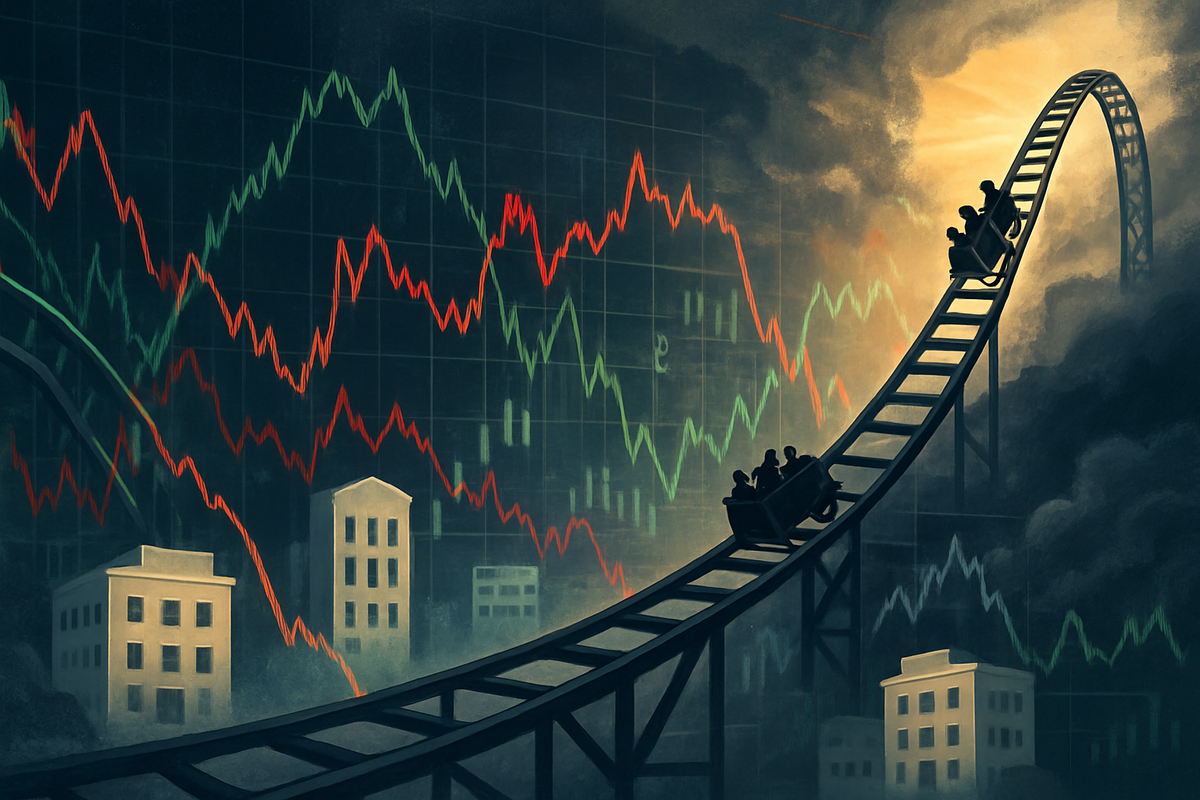
New York, NY – October 17, 2025 – In a financial landscape currently grappling with a significant market sell-off, the notion of analyst upgrades for a highly leveraged exchange-traded fund like ProShares UltraPro Russell2000 (NYSE Arca: URTY) presents a fascinating paradox. While the broader market is experiencing a sharp downturn today, casting a shadow over most positive sentiments, underlying fundamental and technical indicators for the Russell 2000 Index itself have recently shown strength that, in a different environment, would undoubtedly fuel bullish analyst calls. This article will delve into the complex interplay of these factors, dissecting why analysts might consider upgrades for the small-cap sector, even as URTY faces immediate headwinds from a volatile market.
Investors are currently navigating a turbulent session, with Wall Street futures pointing to broad declines across major U.S. indices, including a notable 2% slide in Russell 2000 futures. This immediate market contraction, driven by renewed banking sector concerns and escalating trade tensions, has triggered a flight to safe-haven assets. For URTY, an ETF designed to deliver 3x the daily performance of the Russell 2000 Index, this means magnified losses in the short term. However, beneath this immediate market anxiety, recent data has painted a more optimistic picture for the small-cap companies that comprise the Russell 2000, creating a dichotomy that warrants a deeper look into the potential for future upgrades once the current storm subsides.
The Dual Narrative: Underlying Strength Meets Immediate Headwinds
The narrative surrounding the Russell 2000, and by extension, leveraged products like URTY, is currently bifurcated. On one hand, recent data has provided compelling reasons for optimism regarding the fundamental health of small-cap companies. As of October 16, 2025, just yesterday, the Russell 2000 reported a robust blended earnings growth estimate of 43.2% for the third quarter of 2025. Furthermore, a significant 76.9% of the 39 Russell 2000 companies that had reported Q3 earnings to date surpassed analyst expectations, signaling strong operational performance within the segment. This impressive earnings season for small-caps suggests a resilient corporate foundation, often seen as a bellwether for the broader economy.
Adding to this positive undercurrent, early October 2025 saw technical analysts noting that the Russell 2000 was "finally attempting a breakout," with new uptrends emerging in both European and U.S. markets. Such technical signals often precede periods of sustained growth and can attract significant investor interest. Historically, the Russell 2000 has also shown a tendency to outperform the S&P 500 in the 12 months following presidential elections, a trend observed in five of the last six cycles. This historical precedent, coupled with small-cap companies' reduced reliance on international revenues, positions them favorably in an environment of potential tariffs and a strong U.S. dollar, factors that were being discussed earlier in the year.
However, these encouraging signals are currently overshadowed by the immediate market reality of October 17, 2025. A significant market sell-off, fueled by renewed banking sector concerns and escalating trade tensions, has gripped global markets. This risk-off sentiment has led to a broad decline across indices, with small-cap stocks, typically more sensitive to economic sentiment, experiencing a deeper contraction. For URTY, which seeks to amplify the daily movements of the Russell 2000, this means that any potential for analyst upgrades based on the underlying strength is currently overridden by the magnified negative impact of the market downturn, leading to substantial daily losses for investors.
Small-Cap Constituents: Winners, Losers, and Magnified Exposure
The performance of ProShares UltraPro Russell2000 (URTY) is directly tied to the collective fortunes of the roughly 2,000 small-capitalization companies that constitute the Russell 2000 Index. When analysts consider upgrading the outlook for the small-cap segment, it often reflects a belief in the growth potential of these underlying companies. Sectors within the Russell 2000 that typically benefit from strong economic sentiment and robust earnings include technology, healthcare, and industrials, particularly those with a strong domestic focus. Companies exhibiting solid balance sheets, innovative products, and expanding market share would be the primary beneficiaries of a positive analyst sentiment towards small-caps.
Conversely, in the current environment of market volatility and a significant sell-off, these same companies face considerable pressure. Small-cap firms are often more susceptible to economic contractions, rising interest rates, and tighter credit conditions compared to their large-cap counterparts. The renewed banking sector concerns, a key driver of today's market downturn, could lead to more restrictive lending environments, directly impacting the growth prospects of smaller businesses that rely on external financing. Therefore, while strong Q3 earnings suggest underlying health, the immediate macroeconomic headwinds could translate into a challenging operating environment for many Russell 2000 constituents.
For investors in URTY, the implications are amplified. As a 3x leveraged ETF, URTY magnifies both the gains and losses of the Russell 2000. This means that during periods of positive analyst sentiment and an upward trend in small-cap stocks, URTY would offer substantially higher returns. However, in the current market downturn, the losses experienced by the underlying Russell 2000 companies are tripled for URTY shareholders. This magnified exposure means that even companies that might be fundamentally strong could see their stock prices decline sharply, leading to significant drawdowns for those holding the leveraged ETF. The inherent volatility of small-cap stocks, when combined with 3x leverage, creates an investment vehicle best suited for sophisticated, short-term traders rather than long-term investors seeking passive exposure.
Broader Significance: Volatility, Leverage, and the Economic Barometer
The current scenario surrounding ProShares UltraPro Russell2000 (URTY) and the broader small-cap market is highly significant, reflecting several overarching financial market trends. Firstly, the Russell 2000 is often considered a barometer for the U.S. economy, as its constituents are typically more domestically focused than large-cap companies. The strong Q3 2025 earnings reported by many Russell 2000 companies suggested underlying economic resilience. However, the current market sell-off, driven by banking concerns and trade tensions, indicates that broader macroeconomic anxieties are currently outweighing these positive microeconomic signals. This creates a challenging environment where fundamental strength is temporarily overlooked in favor of risk aversion.
Secondly, the situation highlights the inherent risks and complexities of leveraged ETFs like URTY. These products are designed for daily performance amplification, meaning their returns over periods longer than a single day can significantly diverge from the stated leverage multiple due to compounding and volatility decay. In a highly volatile market, such as the one observed on October 17, 2025, this decay can accelerate, making them particularly unsuitable for long-term holding. The flight to safe-haven assets, with gold and silver hitting record highs, underscores a pervasive risk-off sentiment that makes highly speculative, leveraged instruments exceptionally vulnerable.
Historically, periods of significant market uncertainty often see a rotation out of riskier assets, including small-cap stocks and leveraged funds, into more stable investments. This parallels past financial crises or periods of heightened geopolitical tension. While regulatory bodies continuously monitor the risks associated with leveraged products, the onus remains on investors to fully understand their mechanics and suitability for their investment goals. The current environment serves as a stark reminder of why these instruments are typically recommended for experienced traders with a high tolerance for risk and a clear understanding of daily rebalancing effects.
What Comes Next: Navigating Short-Term Turbulence and Long-Term Potential
Looking ahead, the trajectory for ProShares UltraPro Russell2000 (URTY) and the broader small-cap market is subject to the resolution of current macroeconomic headwinds. In the short term, if banking sector concerns persist and trade tensions escalate, further market declines could be anticipated. For URTY, this would translate into continued magnified losses, making it a challenging environment for even experienced short-term traders. Investors should anticipate heightened volatility and potentially significant drawdowns as the market digests these developments. The immediate focus will be on any policy responses from central banks and governments to stabilize the financial sector and de-escalate trade disputes.
However, the underlying strength indicated by the strong Q3 2025 earnings and earlier technical breakouts for the Russell 2000 suggests a potential for recovery once the immediate market turmoil subsides. If confidence returns to the market, and the economic outlook stabilizes, these small-cap companies could rebound strongly. In such a scenario, analysts might indeed begin to issue upgrades, recognizing the fundamental value and growth potential. For URTY, a sustained upward trend in the Russell 2000 would lead to substantial gains, making it an attractive, albeit high-risk, vehicle for those looking to capitalize on a small-cap resurgence.
Potential strategic pivots for investors include a cautious approach to leveraged ETFs in the current volatile climate, perhaps reducing exposure or employing hedging strategies. Market opportunities may emerge for those with a strong conviction in the long-term health of small-caps, but only once clearer signs of market stabilization appear. Challenges include managing the amplified risk of URTY and accurately timing market turns. Scenarios range from a prolonged period of market contraction, leading to further URTY losses, to a swift resolution of current issues, paving the way for a sharp rebound and potential analyst re-evaluations.
Comprehensive Wrap-Up: A Market at a Crossroads
In summary, the current market environment on October 17, 2025, presents a complex picture for ProShares UltraPro Russell2000 (URTY). While the Russell 2000 Index has recently demonstrated underlying fundamental strength through robust Q3 2025 earnings and positive technical signals, a significant market sell-off driven by banking sector concerns and trade tensions is currently overshadowing these positives. This creates a paradoxical situation where the reasons for potential analyst upgrades exist, but the immediate market conditions make such upgrades unlikely, instead leading to magnified losses for URTY due to its 3x leveraged nature.
Moving forward, the market remains at a crossroads. The resilience shown by small-cap companies in their recent earnings reports suggests a strong foundation that could fuel a recovery. However, the prevailing risk-off sentiment and macroeconomic uncertainties demand caution. Investors in URTY must acknowledge the amplified volatility and the unique characteristics of leveraged ETFs, particularly their susceptibility to volatility decay over longer holding periods.
What investors should watch for in the coming months includes any signs of stabilization in the banking sector, de-escalation of trade tensions, and sustained positive economic data. A clear improvement in these areas could shift market sentiment, allowing the underlying strengths of the Russell 2000 to come to the forefront and potentially trigger the very analyst upgrades that are currently overshadowed. Until then, URTY remains a high-risk, high-reward instrument best suited for active traders who can navigate its magnified daily movements with precision and a clear understanding of market dynamics.
This content is intended for informational purposes only and is not financial advice






